It all started in 1961, at Tama Tech, a Honda-owned amusement park founded on the same philosophy that drives Honda today: mobility through fun, two-wheel vehicles. There, Honda's 49cc-powered Z100 was featured as part of an attraction designed to help park goers experience the joys of riding. So popular amongst guests of all ages and sizes that the bikes quickly earned the nickname of "Monkey," a term originating from how the larger riders looked while riding around. So popular was the attraction that, in 1964, Honda began producing a street-legal version called the CZ100, for European and Asian countries. The craze had started, and it wasn't long until America would get its first taste of Honda miniMOTO fun.
Waiting is the hardest part, but America's delay for a true Honda miniMOTO machine ended in 1968, when the first Z50A was made available in the U.S., complete with 8-inch wheels, knobby tires, adjustable seat, and loveable styling. The best part? A folding handlebar meant parents could stow the bike in the trunk of a car and drive their children to the local riding spot—and probably even go for a ride themselves. Memories were being made, one ride at a time.
Outfitted with a headlight and taillight, the 1969-1970 Z50A served as Honda's quick adjustment to the widespread popularity of the model and opened the door to a wider range of riding. The trend continued, each Z50A being tweaked to fit the needs of its growing fanbase, and in the process, capturing the hearts of Americans. Fun, accessible mobility, through a likable design, tiny dimensions, and low weight, had caught on.
The Z50A's design continued to evolve with features such as dual rear shocks, introduced in 1972.
From there, Honda's North America-bound Z50A models evolved into machines bred for off-road riding, while Europe's Z50J carried the torch as a fun machine for getting around town. But already, the Z50 and its Monkey namesake, had been cemented in millions of hearts by giving countless riders their first experience of twisting the throttle on a powered two-wheeler.
Today, the desire for an easy-to-handle motorcycle that puts a smile on not only the person riding it, but even those who aren't, is alive and well, as evidenced by the success of Honda's Grom. A master of fun, the 2019 Honda Monkey builds on that passion, while celebrating the Z50A models that paved the way for so many riders through the 1960s and '70s, and opening the door to the next generation of enthusiasts.
MODEL OVERVIEW
The classic Monkey style provides the cues for the new model. A trapezoid silhouette highlights the compact length, while simple, curved surfaces harken back to the loveable design of the original Monkey models. Because each part is individually available, Monkey fans can easily express themselves by customizing their bikes.
The glossy 1.47-gallon fuel tank, finished in the same paint color as the frame, swingarm, and shocks, crowns the machine, and proudly wears a historical 3-D Old Wing design Honda logo. Chrome steel high-mount front and rear fenders—plus the evocatively stamped exhaust shield, circular mirrors, and high-rise handlebar—all pay homage to the original.
Modern technology is fully present within the reincarnation of the classic look: a digital full-LCD circular meter features speedometer, odometer with two trip meters, and six-segment fuel-level indicator. All lighting is LED, while the "wave" pattern key (which also wears the Old Wing motif) features an "answer back" system that makes the lights flash at the push of a button to allow easy location in crowded parking lots; the single-channel ABS system operates with an IMU to mitigate rear lift under strong braking.
True to its origins, the Monkey's horizontal SOHC 125cc single-cylinder engine is simple, robust, and tuned to deliver useful around-town performance. Air-cooled, with bore and stroke of 52.4 x 57.9mm and compression ratio of 9.3:1, fed by PGM-FI, it produces strong, enjoyable power all the way through the rev range. An air cleaner, intake tract, and muffler, are specially designed for this model.
The Monkey's steel backbone frame has been tuned for a suitable balance between rigidity and supple feel – perfect for the wide variety of conditions the machine is sure to be ridden in. Oval in cross-section, the swingarm echoes the circular design theme that runs through the bike.
Wheelbase is set at 1,155mm (45.3 in.), while rake and trail are set at 25°/82mm for confidence-inspiring handling. Wet weight is a mere 234 pounds, with a seat height of 30.6 inches. The plush seat is made of high-density urethane for maximum comfort.
The inverted fork is matched by dual shocks for a compliant-yet-sporty ride. A single 220mm front disc and a 190mm rear provide secure stopping performance and are managed by the optional IMU-based ABS. Fat, 12-inch block-pattern tires make for a smooth ride and are sized 120/80-12 65J front and 130/80-12 69J rear.
The 2018 Monkey 125 will be available in two colors:
- Banana Yellow
- Pearl Nebula Red
Key Features
- Components in round shapes contribute to charming appearance
- Head pipe, main frame, and engine hanger plate offer optimal strength for stable handling
- High-density urethane seat with 70mm cushion contributes to comfortable ride and iconic looks
- 125cc single-cylinder engine with dedicated air cleaner, intake tract, and muffler, designed to offer smooth power, with strong power and torque performance between 4,500 and 6,000 rpm for strong performance in around-town riding situations
- LED lighting adds modern touch, durability, and energy efficiency to a classic design
- Optional one-channel ABS
Monkey Milestones
*Not all of these models were imported by American Honda Motor Co.
1961
First model—made for use at amusement parks, with 5-inch wheels, rigid suspension, foldable handlebars, and 4.2 hp 49cc engine.

1963
First road-going model

1967
First model sold in Japan—fold-down seat
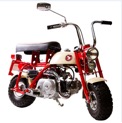
1970
Quick-detach front suspension made it possible to fit in the trunk of a small car
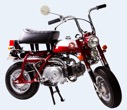
1978
First model with custom-bike-style "tear drop" fuel tank
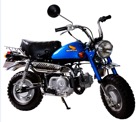
1984
Limited-edition "Gold" model
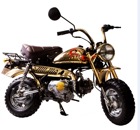
1987
"R" model with twin-tube frame and hydraulic front disc brake
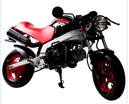
1991
Off-road styled "Baja" model with twin headlights
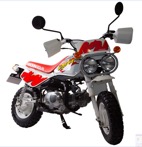
2004 Special
In colors based on the CB750F ridden to victory in the Daytona 100 by Freddie Spencer

2009 Monkey Ltd.
First fuel-injected version, with roller rocker arm and offset cylinder
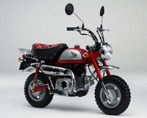
2017
New version commemorates 50th anniversary of sales in Japan

